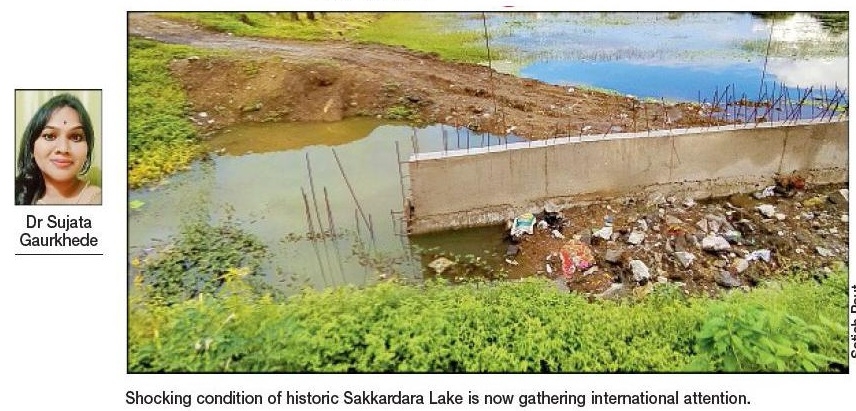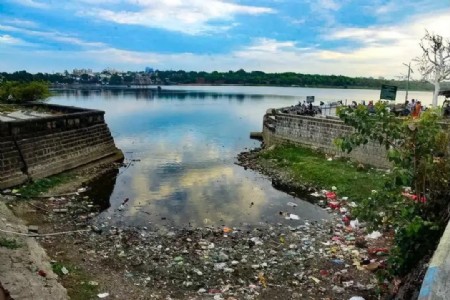Sakkardara Lake’s plight finds international audience
Date :16-Sep-2021

By Shirish Borkar :
THE callous attitude of civic authorities in preserving the cultural heritage of Nagpur has rung alarm bells at international level. Many historians, scholars and prominent Nagpurians conducting in-depth research of the historic Sakkardara Lake are making efforts to “educate the educated” through international seminars. Some historians say that the Sakkardara Lake has been in existence even before the reign of Raghuji Bhosle-II, who was instrumental in deepening the lake bed. A research being pursued by Dr Sujata Gaurkhede, Assistant Professor and ex-Principal of Umme Salma Girls Science & Arts College, Nagpur, after conducting field studies, has attributed the lake to Bhonsla period from 1788 to 1816. Dr Gaurkhede will be presenting her research in an international conference on “Bhonsla period water source and water distribution system in Nagpur district between 1730 and 1853”, in Italy very soon. Talking to ‘The Hitavada’, Dr Gaurkhede said that the issue of conservation of Sakkardara Lake had figured in discussions by scientific community even at international level taking into account the great history attached to the water body.

Dr Gaurkhede said that Gond King Bakht Buland Shah had built the new Nagpur where there were 12 villages. Sakkardara was at number six. At that time Nagpur was called Rajapur Barsa. But Sakkardara was developed by Raghuji Bhonsle-II from 1788 to 1816 and he built a pond on the east side, with a beautiful ghat and entrance on the shore. Hence, this pond was also known after Raghuji-II. In 2005, Sakkardara Pond’s name was changed to Sant Tukaram Maharaj Pond. Raghuji-II made full use of Sakkardara Pond for the Nagpurians. He then started a cannon factory near it, where a large quantity of cannons were made. One of the same cannons is kept in Raj Bhavan even today. Various events were held on this pond on many occasions. Later, it was developed as one of the tourist destinations. “If we look at the entire history of Sakkardara, it is limited to Raghuji-II and Raghuji-IV as the works done by the dynasty were of great importance from historical point of view,” Dr Gaurkhede said. “Until 1958,” she said, “Nagpur was considered to be the only place of interest because of Sakkardara after a black stone temple built in the area. There was a large entrance in front of the temple of Garudeshwar which was built at a distance of about 40 feet which is like the Shukrawari door of a palace in Nagpur.
Above it, there were 18 stairs to reach the top. From there, the temple of Ramtek was also visible. To the left of this temple, there was a huge pond near the beautiful garden. It was about 28 ft long, 60 ft wide, and 12 feet deep with corners were made to put lamps all around. Baradwip pillar and wells were the sources of water in this pond. In the middle was a beautiful stone platform for the King to sit and lamps were placed in the corners all around. On the banks of ‘Pushkarni,’ was a black stone 60 ft long platform and a two storied palace of the Bhosala kings. The castle is not in existence after it was demolished in 2000. In the garden of Sakkardara, water was drawn from the well with the help of 12 oxen and distributed everywhere.” Sakkardara Lake is one of the great symbols of the contribution of the Bhonslas in facilitating water to Nagpur.
The Bhonsla kings dug many ponds, bavalis(stepwells) and wells to provide water to Nagpurians. The contribution of the Bhonslas is of utmost importance in the history of Nagpur. Raghuji Bhonsle-I was the founder of the Bhonsle dynasty of Nagpur in 1730 AD. During Bhonsla period, Jumma Talab or Shukrawari Lake, too, was of great importance. Nag Nadi was the southern boundary of the city. Nawabpura and Juni Mangalwari were on the eastern side. With Hansapuri and Lendi Talab on the northern side, Nagpur city was spread up to Naik Talab. Sakkardara Lake was the third largest sprawling water body of ancient Nagpur and one of the main sources of quenching thirst of the people. It has now almost shrunk due to anthropogenic factors, including mushrooming of illegal constructions sanctioned by authorities. “The authorities should be sensitive enough to understand the historical importance of Sakkardara Lake and preserve it from all possible angles considering its cultural history,” Dr Gaurkhede appealed.







